Navigation
Human Disease Leptospirosis Identified in the Banded Mongoose in Africa
Scientists find widespread but neglected disease is significant health threat in Botswana
The newest public health threat in Africa, scientists have found, is coming from a previously unknown source: the banded mongoose. Leptospirosis, the disease is called. And the banded mongoose carries it. Leptospirosis is the world's most common illness transmitted to humans by animals. It's a two-phase disease that begins with flu-like symptoms. If untreated, it can cause meningitis, liver damage, pulmonary hemorrhage, renal failure and death.
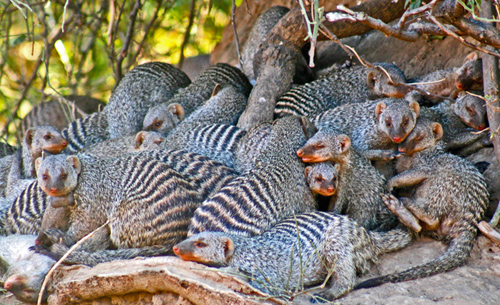 Banded mongoose troops are radio-collared and tracked across the landscape in Botswana.: Photograph courtesy of B. Fairbanks, Virginia Tech
Banded mongoose troops are radio-collared and tracked across the landscape in Botswana.: Photograph courtesy of B. Fairbanks, Virginia Tech
The newest public health threat in Africa, scientists have found, is the disease leptospirosis, carried by a previously unknown source: the banded mongoose.
Leptospirosis is the world's most common illness transmitted to humans by animals. It's a two-phase disease that begins with flu-like symptoms. If untreated, it can cause meningitis, liver damage, pulmonary hemorrhage, renal failure and death.
"The problem in Botswana and much of Africa is that leptospirosis may remain unidentified in animal populations but contribute to human disease, possibly misdiagnosed as other diseases such as malaria," said disease ecologist Kathleen Alexander of Virginia Tech.
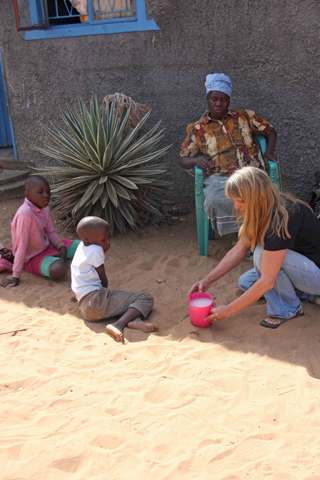 Scientist Kathleen Alexander studies disease transmission in villages in Botswana.: Photograph courtesy of M. Ramotadima, CARACALWith a grant from the National Science Foundation's (NSF) Coupled Natural and Human Systems Program, Alexander and colleagues found that the banded mongoose in Botswana is infected with Leptospira interrogans, the pathogen that causes leptospirosis.
Scientist Kathleen Alexander studies disease transmission in villages in Botswana.: Photograph courtesy of M. Ramotadima, CARACALWith a grant from the National Science Foundation's (NSF) Coupled Natural and Human Systems Program, Alexander and colleagues found that the banded mongoose in Botswana is infected with Leptospira interrogans, the pathogen that causes leptospirosis.
Coupled Natural and Human Systems is part of NSF's Science, Engineering and Education for Sustainability investment and is supported by NSF's Directorates for Biological Sciences; Geosciences; and Social, Behavioral and Economic Sciences.
"The transmission of infectious diseases from wildlife to humans represents a serious and growing public health risk due to increasing contact between humans and animals," said Alan Tessier, program director in NSF's Division of Environmental Biology. "This study identified an important new avenue for the spread of leptospirosis."
The results are published today in a paper in the journal Zoonoses and Public Health. The paper was co-authored by Alexander, Sarah Jobbins and Claire Sanderson of Virginia Tech.
The banded mongoose, although wild, lives in close proximity to humans, sharing scarce water resources and scavenging in human waste.
The disease-causing pathogen it carries can pass to humans through soil or water contaminated with infected urine.
Mongoose and other species are consumed as bushmeat, which may also contribute to leptospirosis exposure and infection in humans.
"I was convinced that we were going to find Leptospira interrogans in some species in the ecosystem," said Alexander.
"The pathogen had not been reported previously in Botswana, with the exception of one cow more than a quarter of a century ago.
"We looked at public health records dating back to 1974 and there were no records of any human cases of leptospirosis. Doctors said they were not expecting to see the disease in patients. They were not aware that the pathogen occurred in the country."
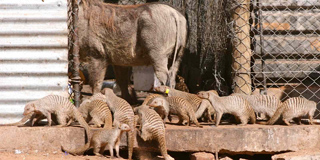 Mongoose, along with other species such as warthogs, are experts at finding human trash.: Photograph courtesy of P. Laver, Virginia TechAlexander conducted a long-term study of human, wildlife and environmental health in the Chobe District of Northern Botswana, an area that includes the Chobe National Park, forest reserves and surrounding villages.
Mongoose, along with other species such as warthogs, are experts at finding human trash.: Photograph courtesy of P. Laver, Virginia TechAlexander conducted a long-term study of human, wildlife and environmental health in the Chobe District of Northern Botswana, an area that includes the Chobe National Park, forest reserves and surrounding villages.
"This pathogen can infect many animals, both wild and domestic, including dogs," said Jobbins. "Banded mongoose is likely not the only species infected."
The researchers worked to understand how people, animals and the environment are connected, including the potential for diseases to move between humans and wildlife.
"Diseases such as leptospirosis that have been around for a very long time are often overlooked amid the hunt for the next newly emerging disease," Alexander said.
Leptospirosis was first described in 1886, said Jobbins, "but we still know little about its occurrence in Africa."
With the new identification of leptospirosis in Botswana, Alexander is concerned about the public health threat it may pose to the immunocompromised population there. Some 25 percent of 15- to 49-year-olds are HIV positive.
"In much of Africa, people die without a cause being determined," she said.
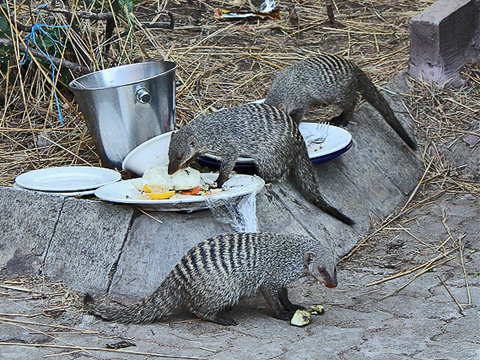 Banded mongoose share the Botswana landscape with humans; leptospirosis often follows.: Photograph courtesy of K. Alexander, Virginia Tech
Banded mongoose share the Botswana landscape with humans; leptospirosis often follows.: Photograph courtesy of K. Alexander, Virginia Tech
"Leptospirosis is likely affecting human populations in this region. But without knowledge that the organism is present in the environment, overburdened public health officials are unlikely to identify clinical cases in humans, particularly if the supporting diagnostics are not easily accessible."
The researchers looked for Leptospira interrogans in archived kidneys collected from banded mongoose that had been found dead from a variety of causes. Of the sampled mongoose, 43 percent tested positive for the pathogen.
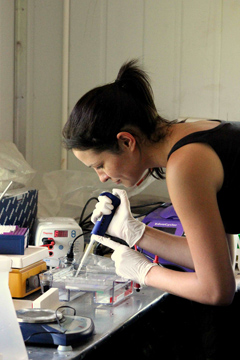 Researcher Sarah Jobbins works in a CARACAL field laboratory in Chobe, Botswana, testing for leptospirosis.: “Human waste in these systems … can be ubiquitous and can influence contact between humans and wildlife and disease transmission in these systems.” “CARACAL is committed to the conservation of wildlife and improving the livelihoods of communities that must live with this resource in Chobe Botswana. Through a combination of research, outreach and education, we work closely with local communities to secure a sustainable future.” Photograph courtesy of I. Moore, CARACAL and caption text is from the CARACAL Web site available at http://www.caracal.info/CARACAL/Welcome_1.html."Given this high prevalence in the mongoose, we believe that Botswana possesses an as-yet-unidentified burden of human leptospirosis," said Jobbins.
Researcher Sarah Jobbins works in a CARACAL field laboratory in Chobe, Botswana, testing for leptospirosis.: “Human waste in these systems … can be ubiquitous and can influence contact between humans and wildlife and disease transmission in these systems.” “CARACAL is committed to the conservation of wildlife and improving the livelihoods of communities that must live with this resource in Chobe Botswana. Through a combination of research, outreach and education, we work closely with local communities to secure a sustainable future.” Photograph courtesy of I. Moore, CARACAL and caption text is from the CARACAL Web site available at http://www.caracal.info/CARACAL/Welcome_1.html."Given this high prevalence in the mongoose, we believe that Botswana possesses an as-yet-unidentified burden of human leptospirosis," said Jobbins.
"There is an urgent need to look for this disease in people who have clinical signs consistent with infection."
Because banded mongoose have an extended range across sub-Saharan Africa, the results have important implications for public health beyond Botswana.
"Investigating exposure in other wildlife, and assessing what species act as carriers, is essential for improving our understanding of human, wildlife, and domestic animal risk of leptospirosis in this ecosystem," the scientists write in their paper.
The paper also cites predictions that the region will become more arid, concentrating humans and animals around limited water supplies and increasing the potential for disease transmission.
"Infectious diseases, particularly those that can be transmitted from animals, often occur where people are more vulnerable to environmental change and have less access to public health services," said Alexander.
"That's particularly true in Africa. While we're concerned about emerging diseases that might threaten public health--the next new pandemic--we need to be careful that we don't drop the ball and stop pursuing important diseases like leptospirosis."
Alexander is working to identify immediate research and management actions, in particular, alerting frontline medical practitioners and public health officials to the potential for leptospirosis in humans.
The WildiZe Foundation also funded the research. Jobbins and Sanderson were supported in part by Virginia Tech's Fralin Life Science Institute.
This news is from the National Science Foundation, 14 May 2013.
Related Websites
NSF Science, Engineering and Education for Sustainability Investment: http://www.nsf.gov/sees
NSF Publication: Discoveries in Sustainability: http://www.nsf.gov/pubs/2012/disco12001/disco12001.pdf
Conservation of African Resources, Animals, Communities And Land Use: http://www.caracal.info
Useful NSF Web Sites:
NSF Home Page: http://www.nsf.gov
NSF News: http://www.nsf.gov/news/
For the News Media: http://www.nsf.gov/news/newsroom.jsp
Science and Engineering Statistics: http://www.nsf.gov/statistics/
Awards Searches: http://www.nsf.gov/awardsearch/
NOTE:
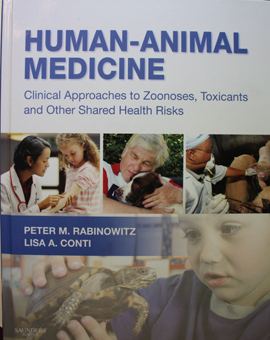
Watch for a Review of the book Humans-Animals Medicine: Clinical Approaches to Zoonoses, Toxicants and Other Shared Health Risks, published by Saunders, an imprint of Elsevier, that will soon appear on the Horizon International Solutions Site.
Leptospirosis, discussed in a section of the extensive chapter on zoonoses, is presented with key points on prevention and control for public health professionals, human health clinicians, and veterinary clinicians. It provides information about the causative agent, “gram-negative spirochete bacteria in the genus Leptospira,” the extensive geographic occurrence, the groups at risk, hosts, reservoir species, vectors, and environmental risk factors.
The authors write, “Leptospirosis is an important occupational disease risk for farmers, dairy and abattoir (slaughterhouse) workers, butchers, hunters, dog handlers, veterinarians, and other veterinary health providers who have direct contact with animals. Workers with exposure to contaminated water, such as military personnel, rice farmers, fishing industry workers, plumbers, and sewage workers, are also at risk.”
Humans-Animals Medicine is by Peter M. Rabinowitz, MD, MPH, Associate Professor of Medicine and Director of Clinical Services Yale Occupational and Environmental Medicine Program, Yale University School of Medicine, and Lisa A. Conti, DVM, MPH, DACVPM, CEHP, the current Deputy Commissioner and Chief Science Officer at Florida Department of Agriculture and Consumer Services. Dr. Rabinowitz serves on the One Health Initiative (OHI) Advisory Board and Dr. Conti is a member of the OHI team along with Laura H. Kahn, MD, MPH, MPP, Bruce Kaplan, DVM, and Jack Woodall, PhD. Dr. Rabinowitz is also Program Director of The Human Animal Medicine Project at Yale School of Medicine on whose research team Dr. Conti serves.
Search
Latest articles
Agriculture
- World Water Week: Healthy ecosystems essential to human health: from coronavirus to malnutrition Online session Wednesday 24 August 17:00-18:20
- World Water Week: Healthy ecosystems essential to human health: from coronavirus to malnutrition Online session Wednesday 24 August 17:00-18:20
Air Pollution
- "Water and Sanitation-Related Diseases and the Changing Environment: Challenges, Interventions, and Preventive Measures" Volume 2 Is Now Available
- Global Innovation Exchange Co-Created by Horizon International, USAID, Bill and Melinda Gates Foundation and Others
Biodiversity
- World Water Week: Healthy ecosystems essential to human health: from coronavirus to malnutrition Online session Wednesday 24 August 17:00-18:20
- Mangrove Action Project Collaborates to Restore and Preserve Mangrove Ecosystems
Desertification
- World Water Week: Healthy ecosystems essential to human health: from coronavirus to malnutrition Online session Wednesday 24 August 17:00-18:20
- UN Food Systems Summit Receives Over 1,200 Ideas to Help Meet Sustainable Development Goals
Endangered Species
- Mangrove Action Project Collaborates to Restore and Preserve Mangrove Ecosystems
- Coral Research in Palau offers a “Glimmer of Hope”
Energy
- Global Innovation Exchange Co-Created by Horizon International, USAID, Bill and Melinda Gates Foundation and Others
- Wildlife Preservation in Southeast Nova Scotia
Exhibits
- Global Innovation Exchange Co-Created by Horizon International, USAID, Bill and Melinda Gates Foundation and Others
- Coral Reefs
Forests
- NASA Satellites Reveal Major Shifts in Global Freshwater Updated June 2020
- Global Innovation Exchange Co-Created by Horizon International, USAID, Bill and Melinda Gates Foundation and Others
Global Climate Change
- World Water Week: Healthy ecosystems essential to human health: from coronavirus to malnutrition Online session Wednesday 24 August 17:00-18:20
- Mangrove Action Project Collaborates to Restore and Preserve Mangrove Ecosystems
Global Health
- World Water Week: Healthy ecosystems essential to human health: from coronavirus to malnutrition Online session Wednesday 24 August 17:00-18:20
- More than 400 schoolgirls, family and teachers rescued from Afghanistan by small coalition
Industry
- "Water and Sanitation-Related Diseases and the Changing Environment: Challenges, Interventions, and Preventive Measures" Volume 2 Is Now Available
- Global Innovation Exchange Co-Created by Horizon International, USAID, Bill and Melinda Gates Foundation and Others
Natural Disaster Relief
- STOP ATTACKS ON HEALTH CARE IN UKRAINE
- Global Innovation Exchange Co-Created by Horizon International, USAID, Bill and Melinda Gates Foundation and Others
News and Special Reports
- World Water Week: Healthy ecosystems essential to human health: from coronavirus to malnutrition Online session Wednesday 24 August 17:00-18:20
- STOP ATTACKS ON HEALTH CARE IN UKRAINE
Oceans, Coral Reefs
- World Water Week: Healthy ecosystems essential to human health: from coronavirus to malnutrition Online session Wednesday 24 August 17:00-18:20
- Mangrove Action Project Collaborates to Restore and Preserve Mangrove Ecosystems
Pollution
- Zakaria Ouedraogo of Burkina Faso Produces Film “Nzoue Fiyen: Water Not Drinkable”
- "Water and Sanitation-Related Diseases and the Changing Environment: Challenges, Interventions, and Preventive Measures" Volume 2 Is Now Available
Population
- "Water and Sanitation-Related Diseases and the Changing Environment: Challenges, Interventions, and Preventive Measures" Volume 2 Is Now Available
- "Water and Sanitation-Related Diseases and the Changing Environment: Challenges, Interventions, and Preventive Measures" Volume 2 Is Now Available
Public Health
- Honouring the visionary behind India’s sanitation revolution
- Honouring the visionary behind India’s sanitation revolution
Rivers
- World Water Week: Healthy ecosystems essential to human health: from coronavirus to malnutrition Online session Wednesday 24 August 17:00-18:20
- Mangrove Action Project Collaborates to Restore and Preserve Mangrove Ecosystems
Sanitation
- Honouring the visionary behind India’s sanitation revolution
- Honouring the visionary behind India’s sanitation revolution
Toxic Chemicals
- "Water and Sanitation-Related Diseases and the Changing Environment: Challenges, Interventions, and Preventive Measures" Volume 2 Is Now Available
- Actions to Prevent Polluted Drinking Water in the United States
Transportation
- "Water and Sanitation-Related Diseases and the Changing Environment: Challenges, Interventions, and Preventive Measures" Volume 2 Is Now Available
- Urbanization Provides Opportunities for Transition to a Green Economy, Says New Report
Waste Management
- Honouring the visionary behind India’s sanitation revolution
- Honouring the visionary behind India’s sanitation revolution
Water
- Honouring the visionary behind India’s sanitation revolution
- Honouring the visionary behind India’s sanitation revolution
Water and Sanitation
- Honouring the visionary behind India’s sanitation revolution
- Honouring the visionary behind India’s sanitation revolution

